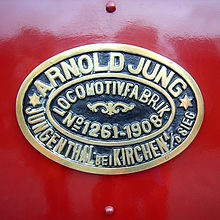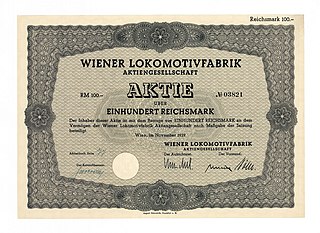




The Arnold Jung Lokomotivfabrik (Arnold Jung Locomotive Works) was a locomotive manufacturer, in particular of Feldbahn locomotives, in Kirchen, Rheinland-Pfalz, Germany.





The Arnold Jung Lokomotivfabrik (Arnold Jung Locomotive Works) was a locomotive manufacturer, in particular of Feldbahn locomotives, in Kirchen, Rheinland-Pfalz, Germany.
The firm was founded on 13 February 1885 as Jung & Staimer OHG by Arnold Jung and Christian Staimer. On 3 September 1885 the first locomotive was delivered. In 1913 the company was renamed Arnold Jung Lokomotivfabrik GmbH, Jungenthal. In 1976 locomotive production was stopped in favour of other products such as machine tools, transporters, armour plating, cranes and bridgelayers.
Jung built more than 12,000 locomotives. In the 1950s it built 51 DB Class 23 2-6-2 locomotives, including in 1959, number 23 105, the last new steam locomotive supplied to the Deutsche Bundesbahn. Jung also made boilers for other uses such as steam rollers.
By the 1950s Jung was also building diesel locomotives, such as the 42 standard gauge Egyptian Republic Railways 4211 class shunters in 1953–56. [1]
Production ceased on 30 September 1993 and the factory closed, but the firm continues to exist as Jungenthal Systemtechnik GmbH.
There are 281 Arnold Jung steam locomotives still extant, according to the list at Steam Locomotive website.
| Built | Works number | Wheel arrangement | Origin | Id | Current location | Notes | Photograph |
|---|---|---|---|---|---|---|---|
| 1892 | 129 | 0-4-0 T | Reykjavík Harbour Railway | Árbær Museum | Pionér is in a shed at the museum – rebuilt 1910 and given a new no.: 1591 [2] |  | |
| 1892 | 130 | 0-4-0 T | Reykjavík Harbour Railway | Reykjavík Harbour | Minør is on a very small section of track in Reykjavík Harbour [2] |  | |
| 1903 | 707–716, 804–808 | 0-6-2 T | Otavi Mining and Railway Company | 1–15 | Tsumeb, Namibia | South West African Jung, Plinthed |  |
| 1906 | 939 | 0-4-0 WT | A gravel washery at Maeseyck | Justine | Toddington Narrow Gauge Railway | In 1974, purchased by a group of enthusiasts, from a Belgian dealer. Briefly returned to Belgium in 1995 to work on a preserved railway. In 2008 worked all the "Santa Specials" on the Lynton and Barnstaple Railway. [3] | |
| 1906 | 964 | 2-6-2 T | Hejaz Railway | 964 | Mada'in Saleh, Saudi Arabia | In a railroad museum workshop at the entrance of the Mada'in Saleh World Heritage Site. | |
| 1908 | 1261 | 0-6-2 WT | Mecklenburgisch-Vorpommersche Schmalspurbahn (MPSB) Nr. 5 / Deutsche Reichsbahn (DR) Nr. 99 3353 | Graf Schwerin-Löwitz | Pont-y-Pant railway station | The Brecon Mountain Railway runs from Pant, near Merthyr Tydfil. |  |
| 1913 | 2008 | Fiabilandia (Rimini) | Used as a children's attraction, near the park station. | ||||
| 1917 | 2279 | 0-4-4-0 T | Ceper Baru Sugar Mill, Java | Tjepper No. 5 | Statfold Barn Railway | ||
| 1925 | 3698 | 0-4-0 T | The Basalt quarry near the village Kausen. | RLJ 2 "A. Dahl" | Risten-Lakvik Railway museum | Came to Sweden in 1971 where it would end up in the hands of Risten-Lakvik Railway Museum in 1975 where it has run tourist trains during the summer since 1979. In 2017 it received a major renovation at Statfold Engineering, which finished in 2020 and is back in service since 2021 | |
| 1926 | 3534 | 0-8-2 T (D1'h2-t) | SHS RU 8 | JDŽ 83-052 | Šarganska osmica |  | |
| 1931 | 3872 | 0-6-0 WT | Used in sugar plantations in the Cameroons. | No 2, KATIE | Bredgar and Wormshill Light Railway |  | |
| 1937 | 7509 | 0-4-0 T | Ginette Marie | In storage at Strumpshaw Hall Steam Museum | Based on the Llanberis Lake Railway from December 1971 to February 1980. [4] | ||
| 1939 | 8692 | 41 303 41 1303-1 Hei Na Ganzlin | Röbel/Müritz | Rekolok , only parts of the locomotive remain |  | ||
| 1940 | 9318 | 41 360 042 360-8 | Dampflok-Tradition Oberhausen | Oil-fired |  | ||
| 1941 | 9322 | 41 364 042 364-0 | Augsburg Railway Park, Augsburg | Oil-fired, new-type boiler '61, Museum locomotive | |||
| 1942 | 9933 | 0-4-0 T | Merrimac (town), Wisconsin | Derelict |  | ||
| 1944 | 10175 | 2-8-2 T (1'D1') | Rhein-Sieg Eisenbahn (RSE) | 53 | Bröl Valley Railway |  | |
| 1952 | 11474 | 2-6-2 (1'C1') | 23 019 023 019-3 | DDM | Museum locomotive | ||
| 1952 | 11969 | 2-6-2 (1'C1') | 23 029 023 029-2 | Ostalbkreis | Aalen trade school centre, Monument | ||
| 1955 | 12081 | 2-8-2 | Hedjaz Jordan Railway | 51 | Hedjaz Jordan Railway | ||
| 1959 | 13113 | 2-6-2 (1'C1') | DB AG | 23 105 023 105-0 | South German Railway Museum (SEH) | Last steam engine delivered to the DB; damaged in the major fire on 17 October 2005, on loan for 10 years to SEH for cosmetic restoration |  |
There is a 5025 steam machine in the "Museo Ferroviario de Santiago de Chile". This machine served in the railway that existed between the Chilean southern towns "Los Sauces" and "Capitan Pastene" (35 km). This railway was begun to be built in 1904 and in 1978 was abandoned.

Under the Whyte notation for the classification of steam locomotives, 0-4-0 represents one of the simplest possible types, that with two axles and four coupled wheels, all of which are driven. The wheels on the earliest four-coupled locomotives were connected by a single gear wheel, but from 1825 the wheels were usually connected with coupling rods to form a single driven set.

Orenstein & Koppel was a major German engineering company specialising in railway vehicles, escalators, and heavy equipment. It was founded on April 1, 1876, in Berlin by Benno Orenstein and Arthur Koppel.

The North British Locomotive Company was created in 1903 through the merger of three Glasgow locomotive manufacturing companies; Sharp, Stewart and Company, Neilson, Reid and Company and Dübs and Company, creating the largest locomotive manufacturing company in Europe and the British Empire and the second largest in the world after the Baldwin Locomotive Works in the United States.
Maschinenbau Kiel GmbH was a German company that designed, manufactured and marketed marine diesel engines, diesel locomotives and tracked vehicles under the MaK brand name. The three primary operating divisions of Maschinenbau Kiel GmbH were sold to different companies in the 1990s.
Kitson and Company was a locomotive manufacturer based in Hunslet, Leeds, West Yorkshire, England.

The TCDD 5701 Class is a class of 2-10-2 side tank steam locomotives for banking at Bilecik. They were the last new main line steam locomotives built for TCDD. Two were built by Henschel in 1951 and two by Arnold Jung Lokomotivfabrik in 1952 based on the German DRG BR 85. The first member of the class, 5701, survives at the Çamlık Railway Museum.

The Schichau-Werke was a German engineering works and shipyard based in Elbing, Germany on the Frisches Haff of then-East Prussia. It also had a subsidiary shipyard in nearby Danzig. Due to the Soviet conquest of eastern Germany, Schichau moved to Bremerhaven in March 1945, and its successors continued in business until 2009.

The steam locomotives of Class 23 were German passenger train locomotives developed in the 1950s for the Deutsche Bundesbahn. They had a 2-6-2 wheel arrangement and were equipped with Class 2'2' T 31 tenders. They were designed to replace the once ubiquitous Prussian P 8 engines that had been built between 1908 and 1924 and, in their day, were the most numerous post-war replacement class.

The Lower Austrian Höllental Railway is a narrow gauge electric railway with a track gauge of 760 mm, which runs from the Austrian Federal Railways (ÖBB) station of Payerbach Reichenau on the Semmering Railway for approximately five kilometres through the market town of Reichenau an der Rax to Hirschwang.

The Sächsische Maschinenfabrik in Chemnitz was one of the most important engineering companies in Saxony in the second half of the 19th century and the first two decades of the 20th century. Including its various predecessor businesses, the firm existed from 1837 until its liquidation in 1930, and individual branches of the company taken over by others continued to operate until 1990. The company is closely linked with the name of its founder and long-time manager, Richard Hartmann, whose name formed part of the new company title in 1898: the Sächsische Maschinenfabrik vormals Richard Hartmann.

Lokomotivfabrik Floridsdorf was an Austrian locomotive works founded on 6 September 1869 that achieved a pre-eminent place amongst European locomotive builders thanks to the quality and diversity of its designs.

These DB Class V 100 diesel locomotives were produced in the late 1950s by the Deutsche Bundesbahn for non-electrified branch lines as a replacement for steam locomotives. The V 100 class was built in three different variants.

Gmeinder GmbH was a German locomotive and engineering company based in Mosbach. Its products included diesel engines, small locomotives (shunters) and other railway locomotive parts. Much of its business came through the German railways, though it also exported to the rest of Europe and the rest of the world.

Schöma is a company based in Diepholz, Germany, specialising in the construction of small diesel locomotives.
The Egyptian Republic Railways 4211 class was a class of 0-6-0 diesel shunter introduced on Egyptian Republic Railways in the 1950s. Arnold Jung Lokomotivfabrik in Jungenthal, Rheinland-Pfalz, Germany built the first batch of 15 in 1953 and the second batch of 27 in 1955–56.

The VR Class Tr1 is a class of heavy freight locomotive built in Finland and Germany. Before 1942 VR Class Tr1s originally had the class name R1. They were nicknamed “Risto”, after the Finnish President Risto Ryti. They were numbered 1030–1096.

The South West African Jung 0-6-2T of 1904 was a narrow gauge steam locomotive from the German South West Africa era.

The kkStB 270 was a class of 2-8-0 locomotives with the Imperial Austrian State Railways, kkStB.

The Lawa Railway was a 173-kilometre-long single-track metre gauge railway in Suriname. It was built during the gold rush in the early 20th century, from the harbour town Paramaribo to Dam at the Sara Creek, but it was not extended to the gold fields at the Lawa River, as originally intended.